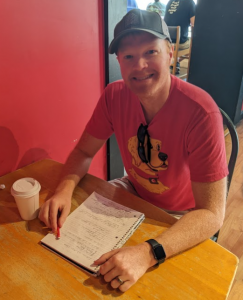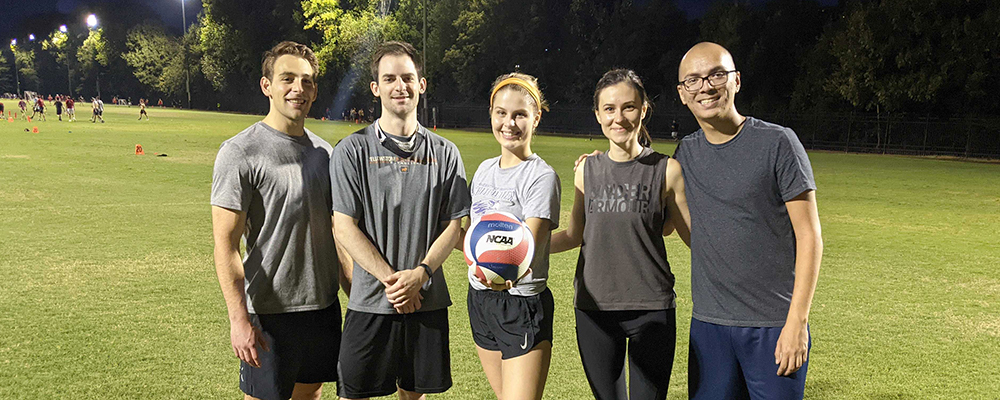
Matthew Cleary (MSA class of ’21) is currently an Advanced Analytics Business Partner at Merz Aesthetics, a pharmaceutical company that specializes in aesthetic medicine. Prior to joining the MSA program he had built a career as a plant biologist, and still has a passion for all things flora. During our interview we discussed Matt’s background in plant biology, what drove him to the field of analytics, and how the IAA prepared him for his new career both technically and professionally.
James: What was your background before you applied to the IAA, and what ultimately drove you to go back to school?
Matt: I was always interested in plant biology from a young age and never wanted an office job, I just wanted to be outside constantly. I don’t know what changed after the first few years in the workforce, but I was traveling a lot, and at a certain point I just didn’t want to travel that much, so I got an agricultural scientist job at BASF where I was exposed to a ton of data. As I moved my way up, I got more interested in the data, and I realized that I really like working with data and spreadsheets. I bought a Python book and read it cover to cover to see if I could try to automate some of the stuff I did, and I started implementing what I learned at BASF. My director said I reduced the time it took for our image analysis pipeline process by 40%! When that happened, I realized I wanted to do data science full time. I decided on a plan to take 6 classes in data science/Python at Wake Tech and then make the jump to apply to the MSA program. I had heard great things about the program and felt that it was the best vehicle to get me to where I wanted to go.
James: How was your student experience at the IAA as someone who had a previous career?
Matt: I was 33 when I started the MSA program, so I was in the top 10% of oldest people in the program, and I was very nervous about that because I felt like I wouldn’t be able to connect with people, especially since this was a COVID year and we were completely virtual. Luckily when I found out I was going to be a team lead, they gave me mostly older people as teammates. As the year went on I was also able to connect with some of the younger folks on my homework teams. I could tell every group I was in looked to me as the leader, probably because of my age, but I also took the IAA super seriously – I prepped forever for this MSA program. I treated it like the students were my coworkers, and we still had fun, but we had stuff to do, and we kept it professional.
James: What was the most rewarding experience for you as an MSA student?
Matt: This might sound odd, but I really enjoyed presenting the final practicum project presentation. At the final presentation, the sponsor brought in high-level directors and one C-suite level person, so it gave us an opportunity to talk to very high-up people. The questions they asked us were very different from our sponsor’s questions, they were asking how these things we built could be applied. So you got to see insight into a real business, and see how they are going to use what we produced. My sponsor even ended up using the dashboard that we made!
James: How specifically has the IAA prepared you for your new career both technically and professionally?
Matt: Working on teams and having them be switched up constantly was incredibly beneficial for me, I’ve been on teams where you’re with those people forever and roles are defined. But switching up teams forces you to relearn and adapt, and it gave me communication skills that I didn’t have before. I was very introverted, but doing that forced me to go out of my shell/step up and say to myself “Hey I need to bring something to the table, I need to present my ideas and not just coast in the background”. So that helped a ton. Couple that with all the presentations that we had to do, (I hated public speaking at first) and it really helped me tremendously. Just this past Friday I had to give a presentation, and I thought back to Dr. Egan Warren – I could hear her voice in my head. I would just think of all the techniques I used to do, and it’s still sticking with me every time I need to present. For technical skills – I use time series a lot, I made an entire pipeline for time series in R. Also, a lot of regularized regression to find variables of interest. When I’m looking at a big data set, I’ll use lasso regression to find just the variables that are important and say “These are the drivers of this business.”
James: Did your first job out of school match your expectations when you started the MSA program?
Matt: I wanted to stay in a science field, because I felt that I couldn’t get a top-tier business job right away. So I took a job at Locus Bioscience, which was a startup company in RTP, and I was part of their bioinformatics team. This was great for two reasons- it was my first job as a data analyst, and it was a startup, so I got to wear every kind of hat imaginable. I got to be both a data scientist and data engineer, and present findings to the top of the company. However, I was working 60 – 70 hours a week, and I decided to do it for just one year to get the experience. It was a great bridge between still doing some science work and being a full-time analyst. The first job out of school doesn’t have to be your dream job or your forever job, it can be a bridge job too.
James: You currently work with Merz Aesthetics, can you talk about why you chose them and how you’re currently applying analytics to your job?
Matt: The biggest thing is that I got poached by a director at Merz. This director created a new position and needed a data scientist. I came referred by a mutual friend who worked at Merz. I became the lone data scientist on the commercial analytics team. We do advanced stuff for marketing and finance, and that’s where I come in. I took the job because I really liked the company- it has a great culture and work-life balance. I try to do mostly marketing analytics, and one of the things I just presented on was a customer segmentation model, so I’m using what’s called RFM customer segmentation (recency, frequency, monetary value). This model looks at when a customer last ordered, how much they ordered, and how much they spent per order. We try to segment the customers that way, then couple that with a customer lifetime value model. That is a Bayesian model that looks at predicting the one year spend for a customer, and then their daily churn risk. So every single day for a year, what is their churn risk, what is the probability that they’re active today? Our field representatives can then go out and say “These people are at risk of leaving today, lets reach out to them and turn that around”. I just presented these two models to our field reps and it went over quite well. They usually push back on stuff like this, but this time they fully adopted it, and we’re going to roll it out next month!
James: What is the coolest/most rewarding thing you’ve worked on since graduating from the MSA program?
Matt: Even though I am proud of the models we just talked about, I have a different answer to this question. When you work on something early on, it might not be the most impactful thing, but it’s something that always sticks with you. At my first post-MSA job at Locus Bioscience, we had this image analysis system where we took pictures of plates of bacteria, and then an algorithm would count how many bacterial colonies were on any cell. We had three different algorithms to do the counts, and usually all three agree. If one of them didn’t agree, then we needed to go in and check it manually. So, I made a dash-plotly (web tool) which is hosted on Google Cloud. People could go in there and put their experiment number in, and my script would go into all the different results for those cells and find the cells where the three algorithms didn’t agree on the count. Then it would download their pictures as well as an Excel spreadsheet with every single plate in the order that needed to be reviewed. This tool saved my department a lot of time. I had to learn Docker for this one, as well as Google Cloud and GitHub (automatic triggers to take output from lab robots and put it in different folders, then having a program to look every hour at new folders). Everything was automated, using continuous integration/continuous delivery (CICD).
James: Lastly, do you have any recommendations or advice for MSA students that have a similar background to yourself?
Matt: Don’t downplay what you’re bringing to the table, everyone has different backgrounds, especially in this program. I was plant biology. I struggled with imposter syndrome at first, but then I realized that I have the communication skills that many of my peers didn’t just from working for 10 years. So I was bringing quite a bit to the table. Know that you can be a boon to your teammates even if you have a different background. Keep a plan in mind for what you want to do after the program. The hard part about this program is that in other grad schools you have choices in the track that you want to go down. In this program, everyone goes in the same curriculum. You need to take what you learn in this program and apply it to what you want to do, so take the time to research different industries now. You’ve got this!

In conclusion, I would like to thank Matt for his willingness to participate in this interview. It was an invaluable opportunity to learn about his professional journey, which I was especially interested in as someone who also had work experience prior to joining the MSA program. Hearing from an alumnus with a unique educational background gave me a fresh perspective on how diverse experiences can shape approaches to data science, underscoring that there is no single path to a career in analytics.
Additionally, I was intrigued to learn about Matt’s current work, as it represents the kind of real-world applications of data science that inspire me. Understanding how he tackles the challenges of his roles sparked new ideas for strategies I can apply to my own projects, broadening my understanding of the field and deepening my enthusiasm for a data-driven career.
Columnist: James Faber
